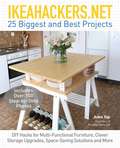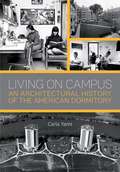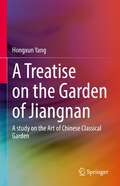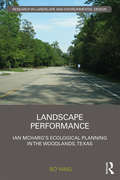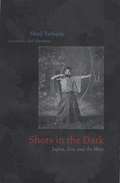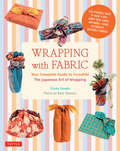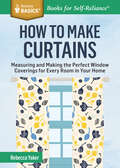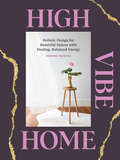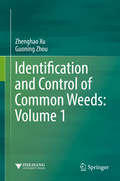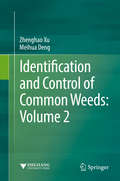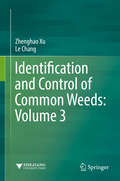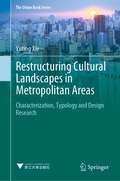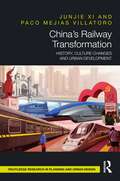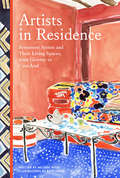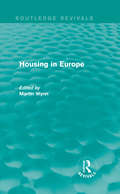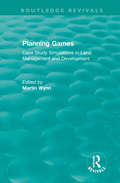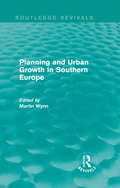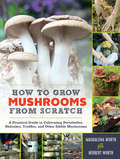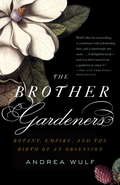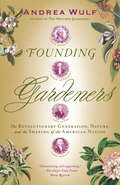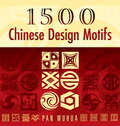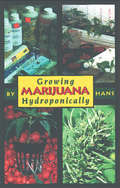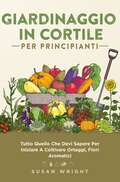- Table View
- List View
IKEAHACKERS.NET 25 Biggest and Best Projects: DIY Hacks for Multi-Functional Furniture, Clever Storage Upgrades, Space-Saving Solutions and More
by Jules YapThe ingenious team at IkeaHackers.net show you how to transform affordable IKEA products into creative new furniture and more!Jules Yap and the contributors to her wildly popular website IkeaHackers.net show you how to transform affordable IKEA® products into creative new furniture and more. With clear instructions and easy-to-follow photos, you&’re sure to have fun building these exciting hacks, including: • Kitchen Island• Dollhouse• Vanity• Built-In Home Office• Mudroom Bench
Living on Campus: An Architectural History of the American Dormitory
by Carla YanniAn exploration of the architecture of dormitories that exposes deeply held American beliefs about education, youth, and citizenshipEvery fall on move-in day, parents tearfully bid farewell to their beloved sons and daughters at college dormitories: it is an age-old ritual. The residence hall has come to mark the threshold between childhood and adulthood, housing young people during a transformational time in their lives. Whether a Gothic stone pile, a quaint Colonial box, or a concrete slab, the dormitory is decidedly unhomelike, yet it takes center stage in the dramatic arc of many American families. This richly illustrated book examines the architecture of dormitories in the United States from the eighteenth century to 1968, asking fundamental questions: Why have American educators believed for so long that housing students is essential to educating them? And how has architecture validated that idea? Living on Campus is the first architectural history of this critical building type. Grounded in extensive archival research, Carla Yanni’s study highlights the opinions of architects, professors, and deans, and also includes the voices of students. For centuries, academic leaders in the United States asserted that on-campus living enhanced the moral character of youth; that somewhat dubious claim nonetheless influenced the design and planning of these ubiquitous yet often overlooked campus buildings. Through nuanced architectural analysis and detailed social history, Yanni offers unexpected glimpses into the past: double-loaded corridors (which made surveillance easy but echoed with noise), staircase plans (which prevented roughhousing but offered no communal space), lavish lounges in women’s halls (intended to civilize male visitors), specially designed upholstered benches for courting couples, mixed-gender saunas for students in the radical 1960s, and lazy rivers for the twenty-first century’s stressed-out undergraduates. Against the backdrop of sweeping societal changes, communal living endured because it bolstered networking, if not studying. Housing policies often enabled discrimination according to class, race, and gender, despite the fact that deans envisioned the residence hall as a democratic alternative to the elitist fraternity. Yanni focuses on the dormitory as a place of exclusion as much as a site of fellowship, and considers the uncertain future of residence halls in the age of distance learning.
A Treatise on the Garden of Jiangnan: A study on the Art of Chinese Classical Garden
by Hongxun YangThis book presents a study into the art of Jiangnan classical garden. Jiangnan (“the south of the Yangtze River”) refers to the water network region along the lower reaches of the Changjiang River (formerly known as Yangtze River), where Jiangsu Province Chinese gardens were primarily constructed during the 16th and 17th centuries of the later Ming and early Qing dynasties. The Jiangnan garden, an architectural space where artificial and natural elements are combined, represents the elite of classical Chinese gardens and serves as a prime exemplar for its northern counterpart, the Ming and Qing imperial gardens.The book pursues an interdisciplinary approach, combining historical information with case studies and other methods. Charts and pictures are used to supplement and reinforce the conclusions drawn from the macro narrative, enhancing the authenticity and readability of the historical monographs. It represents the first study of the classical art of landscape design in China, offering readers an insightful introduction.
Landscape Performance: Ian McHarg’s ecological planning in The Woodlands, Texas (Routledge Research in Landscape and Environmental Design)
by Bo YangIan McHarg’s ecological planning approach has been influential since the 20th century. However, few empirical studies have been conducted to evaluate the performance of his projects. Using the framework of landscape performance assessment, this book demonstrates the long-term benefits of a renowned McHargarian project (The Woodlands town development) through quantitative and qualitative methods. Including 44 black and white illustrations, Landscape Performance systematically documents the performance benefits of the environmental, social, and economic aspects of The Woodlands project. It delves into McHarg’s planning success in The Woodlands in comparison with adjacent Houston developments, which demonstrated urban resilience after Hurricane Harvey in 2017. Lastly, it identifies the ingredients of McHarg’s ability to do real and permanent good. Yang also includes a number of appendices which provide valuable information on the methods of assessing performance in landscape development. This book would be beneficial to academics and students of landscape architecture and planning with a particular interest in Ian McHarg.
Peace of Mind in Earthquake Country
by Peter YanevThe geologic, architectural and structural hazards of earthquakes, and how to recognize, avoid or correct them.
Shots in the Dark: Japan, Zen, and the West
by Shoji Yamada Earl Hartman S. YamadaIn the years after World War II, Westerners and Japanese alike elevated Zen to the quintessence of spirituality in Japan. Pursuing the sources of Zen as a Japanese ideal, Shoji Yamada uncovers the surprising role of two cultural touchstones: Eugen Herrigel's Zen in the Art of Archery and the Ryoanji dry-landscape rock garden. Yamada shows how both became facile conduits for exporting and importing Japanese culture.
Wrapping with Fabric
by Etsuko Yamada Kanji OkamotoWrap anything from a wine bottle to a yoga mat with this practical Japanese fabric-wrapping book.Long before today's eco-friendly philosophy of "reduce, reuse, recycle" entered America's collective consciousness, furoshiki--the Japanese method of wrapping things with fabric--?ourished as a time-honored and practical art form. In Wrapping With Fabric, Etsuko Yamada--born into a long-line of furoshiki makers in Kyoto--explains the "one cloth, many uses" ideology behind the craft, the etiquette of color and the craft's fascinating history. From there, she shares the myriad ways in which a few basic techniques can transform a simple square of cloth into an elegant wrapper. Use your folded fabrics to: Gift-wrap anything from books to flowers Bundle up a picnic Tote items ranging from wine bottles to yoga mats Use as a handbag or backpack Make into a pillow covering Create decorative coverings for vases, tissue boxes, and moreA quiet reminder that opportunities for artistry are everywhere around you, Wrapping With Fabric is the craft book that makes it easy to bring a touch of grace and ingenuity to everyday life--and help preserve the environment, too.
Wrapping with Fabric
by Etsuko YamadaLong before today's eco-friendly philosophy of "reduce, reuse, recycle" entered America's collective consciousness, furoshiki-the Japanese method of wrapping things with fabric-?ourished as a time-honored and practical art form. In Wrapping With Fabric, Etsuko Yamada-born into a long-line of furoshiki makers in Kyoto-explains the "one cloth, many uses" ideology behind the craft, the etiquette of color and the craft's fascinating history. From there, she shares the myriad ways in which a few basic techniques can transform a simple square of cloth into an elegant wrapper you can use to: Gift-wrap anything from books to flowers Bundle up a picnic Tote items ranging from wine bottles to yoga mats Use as a handbag or backpack Make into a pillow covering Create decorative coverings for vases, tissue boxes, and more A quiet reminder that opportunities for artistry are everywhere around you, Wrapping With Fabric makes it easy to bring a touch of grace and ingenuity to everyday life-and help preserve the environment, too.
How to Make Curtains: Measuring and Making the Perfect Window Coverings for Every Room in Your Home. A Storey BASICS® Title (Storey Basics)
by Rebecca YakerRebecca Yaker, co-author of the best-selling One-Yard Wonders, offers this complete introduction to making your own curtains, covering everything from measuring to calculating yardage, choosing the best fabrics, sewing your curtains, adding linings, and selecting the right fixtures and hardware for hanging. She includes step-by-step instructions for making five different curtain styles: pleats, eyelets, tab tops, tie tops, and rod pockets.
High Vibe Home: Holistic Design for Beautiful Spaces with Healing, Balanced Energy
by Kirsten YadougaFrom an interior designer and modern feng shui expert, High Vibe Home is a luxe handbook for creating restorative spaces that feel as good as they look.Create a home that feels as good as it looks. From an interior designer and energy practitioner, High Vibe Home teaches readers how to design harmonious spaces that invite free-flowing, positive energy into their homes and lives. By decluttering and cleaning, arranging furniture, decorating with crystals or houseplants, incorporating new colors, textures, and more, anyone, on any budget, can design a home with high vibes. The book outlines key design principles and energy rules that contribute to a nourishing home, and then, room-by-room, offers achievable ways to put those practices into place. In a luxe package, this handbook is woven through with atmospheric photography, evocative shots of styled decor elements, and helpful diagrams. High Vibe Home is a must-have for design aficionados, wellness enthusiasts, and anyone interested in crystals, feng shui, or energy work. Alongside smudge sticks or a cozy throw, it's a thoughtful gift for a girlfriend's birthday or a housewarming party.ACCESSIBLE PRACTICES: High Vibe Home offers achievable, affordable practices to make spaces feel more Zen. Anyone, on any budget, can make these small adjustments to improve their home and in turn, channel that newfound positive energy into other areas of their life.MORE THAN JUST HOME DECOR: This book is not simply a collection of design tips; it also teaches how to foster specific types of energy in your space—calming, invigorating, healing, etc. These choices can have an outsize impact on not just your mood but also your relationships, career, and health.ON TREND: The wellness trend is still going strong, and holistic interior design is an extension of that. There are sections throughout the book on crystals, chakras, feng shui, and other types of energy work, which will appeal to those interested in these on-trend wellness topics.Perfect for:• Anyone looking for ways to make their home lovelier or more Zen• People interested in energy work, crystals, or feng shui• Shoppers looking for a Mother's Day, hostess, or housewarming gift
Identification and Control of Common Weeds: Volume 1
by Zhenghao Xu Guoning ZhouThis book introduces readers to nearly 600 common weeds. In addition to essential information, each chapter includes photos for a specific type of weed to show its morphology in different growth periods, such as seedling, root, flower, fruit, and mature plant. The book also discusses control measures, including agricultural, chemical, physical, biological, and comprehensive methods. The Volume1 mainly focuses on 126 species of grass weeds and 34 species of sedge weeds. With the development of society and economics, weeds have become a recurring problem. In particular, the exotic, invasive, and quarantine weeds have spread dramatically and rapidly. On the other hand, many people, even those who are engaged in weed control, do not (or cannot) distinguish between weeds. Thus there is significant demand for illustrations of weed morphologies, as well as information on their control measures. This book offers a valuable, practical guide for all those working in the fields of crop cultivation, plant protection and quarantine management.
Identification and Control of Common Weeds: Volume 2
by Zhenghao Xu Meihua DengThis book introduces readers to nearly 600 common weeds. In addition to essential information, each chapter includes photos for a specific type of weed to show its morphology in different growth periods, such as seedling, root, flower, fruit, and mature plant. The book also discusses control measures, including agricultural, chemical, physical, biological, and comprehensive methods. The Volume2 mainly focuses on fern and 216 species of weeds of magnoliids or dicotyledoneae. With the development of society and economics, weeds have become a recurring problem. In particular, the exotic, invasive, and quarantine weeds have spread dramatically and rapidly. On the other hand, many people, even those who are engaged in weed control, do not (or cannot) distinguish between weeds. Thus there is significant demand for illustrations of weed morphologies, as well as information on their control measures. This book offers a valuable, practical guide for all those working in the fields of crop cultivation, plant protection and quarantine management.
Identification and Control of Common Weeds: Volume 3
by Zhenghao Xu Le ChangThis book introduces readers to nearly 600 common weeds. In addition to essential information, each chapter includes photos for a specific type of weed to show its morphology in different growth periods, such as seedling, root, flower, fruit, and mature plant. The book also discusses control measures, including agricultural, chemical, physical, biological, and comprehensive methods. The Volume 3 mainly focuses on 252 Species of Dicotyledonous and Monocotyledonous Weeds along with 2 Species of Liverworts and Mosses. With the development of society and economics, weeds have become a recurring problem. In particular, the exotic, invasive, and quarantine weeds have spread dramatically and rapidly. On the other hand, many people, even those who are engaged in weed control, do not (or cannot) distinguish between weeds. Thus there is significant demand for illustrations of weed morphologies, as well as information on their control measures. This book offers a valuable, practical guide for all those working in the fields of crop cultivation, plant protection and quarantine management.
Restructuring Cultural Landscapes in Metropolitan Areas: Characterization, Typology and Design Research (The Urban Book Series)
by Yuting XieThis book introduces a ten-year-long design research project in the Yangtze River Delta (YRD), China, based on international cooperation studios, design workshops, a Ph.D. thesis, and concrete practice in China, Germany, and the Netherlands. This research adapts the existing methods of Landscape Character Assessment (UK), Historic Cultural Landscape Elements (Germany), and Dutch Polder Typology to mapping, describing, and classifying landscape character areas and types at the three scales of regional, municipal, and local. Furthermore, to connect research with design, we developed a typological approach of generating specific measures for the networked polder landscape. This research bridges the gap of a missing landscape characterization method for the conservation, transformation, and critical reconstruction of historic cultural landscapes in a metropolitan context. The book is intended for graduate students, researchers, and practitioners interested in the topics of cultural landscape in transition, methods for landscape characterization and typology, and a research-by-design approach in interdisciplinary projects of landscape architecture, urbanism, and regional planning.
China’s Railway Transformation: History, Culture Changes and Urban Development
by Junjie Xi Paco Mejias VillatoroThis book investigates China’s railway transformation through history, along with culture changes and urban development. The book begins by looking at the background of China and the history and growth of railway development in China through five key phases, followed by assessing the cultural changes in the railway carriage and exploring how these are linked to social equality and national provisions. The core of this book aims to analyse the Chinese urban transformation through the development of the high-speed rail (HSR) infrastructure in China. Eleven important new HSR stations in mainland China, plus the new Hong Kong West Kowloon Station, have been selected to contextually explore how HSR infrastructures have affected the development of the Chinese urban context. The selected case studies are the stations of Beijing South, Wuhan, Shanghai Hongqiao, Guangzhou South, Xi’an North, Nanjing South, Chengdu East, Tianjin West, Zhengzhou East, Hangzhou East and Hong Kong West Kowloon. All of these were built between 2008 and 2018. In these case studies, the location and the intentions and success of promoting urban development are analysed and assessed. Following this, the book further investigates the peculiarities of the new HSR stations in China in comparison with stations in Europe. An assessment framework is established to evaluate the Chinese case studies comparatively with significant cases in Europe, attending to the urban structure of the area, the architectural quality, the functional diversity and the quality of the public space generated in the surrounding area.
Artists in Residence: Seventeen Artists and Their Living Spaces, from Giverny to Casa Azul
by Melissa WyseArtists in Residence explores the homes of 17 legendary and contemporary artists.Readers can peek inside Georgia O'Keeffe's adobe courtyards, stroll through Henri Matisse's vibrant aviary, and peruse Jean-Michel Basquiat's collection of over 1,000 videotapes.A house or an apartment is not simply a place to eat and sleep for these artists; they transform quotidian spaces into dynamic reflections of their individual artistic preoccupations.• Offers a fascinating and inspiring blend of art history, interior design, and travel• Invites readers to peer behind the closed doors of top artists from around the world• Richly illustrated throughoutThrough vivid text and image, Artists in Residence explores how each artist's living space relates to their individual and distinct artist practice.Readers gain a deeper appreciation of their favorite artists' work, and perhaps discover a new favorite visual along the way.• This petite jacketed hardcover book makes a wonderful gift for artists and art fans everywhere.
Routledge Revivals: Housing In Europe (1984) (Routledge Revivals)
by Martin WynnFirst published in 1984, this book presents a survey of housing problems in various European countries and how individual states have responded. Each chapter begins by surveying the problem in each country since the Second World War, before going on to outline the roles fulfilled by national housing agencies and local authorities, as well as assessing the impact of housing policies on society and on the physical shape of cities. It considers whether housing policies have succeeded or failed and how the ‘housing problem’ has changed over time. Each chapter draws out lessons that can be learned for the future from each country’s past handling of the problem. This book will be a useful reference for those interested in housing, including planners, geographers, economists, sociologists or policy-makers.
Routledge Revivals: Case Study Simulations in Land Management and Development (Routledge Revivals)
by Martin WynnFirst published in 1985, this book presents seven games for use in the teaching and study of planning, urban studies or land administration. These simulations are all built on researched case studies and deal with a number of critical planning and developmental issues; for each one the book provides full operational instructions and all gaming materials required. The games in this volume cover a number of scenarios, including the design of a mixed retail, social and service centre in a new city, new development in a run-down inner city area, rehabilitation or renewal of housing, tourist development in the Mediterranean and a new cross-town motorway in a major north American city. In addition, sets of guidelines for those wishing to design and operate their own case study simulations are also included. This book will be a valuable resource for students of town planning or urban development who are keen to gain ‘hands-on’ experience of using the professional skills they have acquired on their courses.
Routledge Revivals: Planning And Urban Growth In Southern Europe (1984) (Routledge Revivals)
by Martin WynnFirst published in 1984, this book addresses key questions about the pattern of urban development in Southern Europe and the mechanisms employed to control and regulate this development in individual countries. It examines five countries – Greece, Italy, Portugal, Spain and Turkey – that have experienced different scales and rates of urbanization and industrialization. It identifies common problems arising from these processes, as well as the successes and failures of the planning policies employed to regulate development. This book will be of great value to geographers interested in Southern Europe and urban and regional planners interested in comparative patterns of development.
How to Grow Mushrooms from Scratch: A Practical Guide to Cultivating Portobellos, Shiitakes, Truffles, and Other Edible Mushrooms
by Magdalena Wurth Herbert WurthYes, you can grow mushrooms from scratch!Why grow mushrooms? Mushrooms are a joy to grow—for food, as a garden feature, or just for fun—and it’s easier than you think! How to Grow Mushrooms from Scratch covers 19 varieties, from button (always versatile) to reishi (a medicinal powerhouse). Plus, here are delicious recipes, preserving methods, and more.Where can you grow mushrooms? Mushrooms will thrive in your garden, on your windowsill, and even in your basement. The key is to pick the right growing medium for your mushroom—a log, a bale of hay, or a simple pot of dirt—and give it a little shade.How to grow mushrooms! Experts Magdalena and Herbert Wurth explain every step of cultivation—whether starting from a kit, a culture, or a grown mushroom you’d like to propagate. From protecting mushrooms in extreme weather, to troubleshooting pests, here is expert advice for beginners and experienced growers alike!
The Brother Gardeners: Botany, Empire and the Birth of an Obsession
by Andrea WulfOne January morning in 1734, cloth merchant Peter Collinson hurried down to the docks at London's Custom House to collect cargo just arrived from John Bartram, his new contact in the American colonies. But it was not reels of wool or bales of cotton that awaited him, but plants and seeds... Over the next forty years, Bartram would send hundreds of American species to England, where Collinson was one of a handful of men who would foster a national obsession and change the gardens of Britain forever, introducing lustrous evergreens, fiery autumn foliage and colourful shrubs. They were men of wealth and taste but also of knowledge and experience like Philip Miller, author of the bestsellingGardeners Dictionary,and theSwede Carl Linnaeus, whose standardised botanical nomenclature popularised botany as a genteel pastime for the middle-classes; and the botanist-adventurer Joseph Banks and his colleague Daniel Solander who both explored the strange flora of Tahiti and Australia on the greatest voyage of discovery of modern times, Captain Cook'sEndeavour. Thisis the story of these men - friends, rivals, enemies, united by a passion for plants - whose correspondence, collaborations and squabbles make for a riveting human tale which is set against the backdrop of the emerging empire, the uncharted world beyond and London as the capital of science. From the scent of the exotic blooms in Tahiti and Botany Bay to the gardens at Chelsea and Kew, and from the sounds and colours of the streets of the City to the staggering vistas of the Appalachian mountains,The Brother Gardenerstells the story how Britain became a nation of gardeners.
Founding Gardeners: How the Revolutionary Generation Created an American Eden
by Andrea WulfFrom the author of the acclaimed The Brother Gardeners, a fascinating look at the founding fathers from the unique and intimate perspective of their lives as gardeners, plantsmen, and farmers. For the founding fathers, gardening, agriculture, and botany were elemental passions, as deeply ingrained in their characters as their belief in liberty for the nation they were creating. Andrea Wulf reveals for the first time this aspect of the revolutionary generation. She describes how, even as British ships gathered off Staten Island, George Washington wrote his estate manager about the garden at Mount Vernon; how a tour of English gardens renewed Thomas Jefferson's and John Adams's faith in their fledgling nation; how a trip to the great botanist John Bartram's garden helped the delegates of the Constitutional Congress break their deadlock; and why James Madison is the forgotten father of American environmentalism. These and other stories reveal a guiding but previously overlooked ideology of the American Revolution. Founding Gardeners adds depth and nuance to our understanding of the American experiment and provides us with a portrait of the founding fathers as they've never before been seen.
1500 Chinese Design Motifs (Dover Pictorial Archive)
by Pan WuhuaThese crisp, black-and-white images will lend a distinctive Far Eastern accent to any project. Hundreds of eye-catching images include geometrics, abstracts, optical illusions, plus other intriguing configurations that adapt easily for use as spot illustrations or as repeating patterns. Professional and amateur artists, illustrators, and designers will find this inexpensive treasury a priceless source of royalty-free inspiration.
Growing Marijuana Hydroponically
by Tina Wright HansGROWING MARIJUANA HYDROPONICALLY shows how to grow marijuana indoors utilizing the Sea of Green Perpetual Harvest process adapted by Hans into a "cottage" approach.The Sea of Green Perpetual Harvest is the simplest, quickest method for hydroponic marijuana cultivation. The time required to produce perpetual buds of marijuana is reduced dramatically because the process eliminates the need to grow an entire plant. Instead only amazing mega-buds are grown-perpetually.GROWING MARIJUANA HYDROPONICALLY includes a day-to-day, week-by-week description of the Hans "cottage" hydroponic gardening technique-in non-technical language.IncludesGrow room set-upAir circulationSeed germinationNutrientsWater healthCloningEdd and flowFilm/flowWickDetermining genderBlooming and harvestand more . . .Hydroponic cultivation is especially good for growing marijuana for medical use because it produces a harvest of organic chemical-free marijuana with sweet-tasting smoke.
Giardinaggio In Cortile Per Principianti: Tutto Quello Che Dovete Sapere Per Iniziare A Coltivare Verdure, Fiori Ed Erbe In Casa.
by Susan WrightVolete imparare a piantare gustose verdure, erbe e bellissimi fiori nel vostro giardino? Volete creare un giardino nel vostro cortile di casa, ma non sapete da dove iniziare? Sapevate che il giardinaggio può anche aiutare a migliorare la vostra salute in molti modi diversi? Avete degli obiettivi per il vostro giardino, ma non sapete come raggiungerli? State cercando una risorsa che vi aiuti a capire il giardinaggio e come iniziare subito? Se questo è il vostro caso, allora continuate a leggere! Il giardinaggio è un hobby che può essere imparato e insegnato. Il giardinaggio può essere un modo divertente e piacevole per entrare in contatto con la natura e vi darà anche l'opportunità di provare nuove ricette nutrienti e modi di mangiare che piaceranno a voi e alla vostra famiglia. Coltivare una varietà di cibo è tanto efficace quanto vantaggioso. Il giardinaggio è un'attività che richiede un pò di pazienza, ma alla fine è gratificante mangiare prodotti freschi che voi stessi avete coltivato. Imparare a fare giardinaggio vi aiuterà a raggiungere tutti i vostri obiettivi, non importa quanto grandi o piccoli essi siano. Indipendentemente da chi siete e da cosa volete realiizare, la base del giardinaggio è la stessa per tutti. Questo libro vi farà capire tutto quello che dovete sapere sul giardinaggio in cortile, compresi i vantaggi e le sfide che porta, e vi fornirà un progetto passo dopo passo per raggiungere un livello superiore di comprensione della materia, insieme ad alcuni consigli e processi pratici che potete mettere in pratica subito. Non c'è mai stato un libro così delicato nel suo approccio e così efficace nell'aiutare le persone a capire come iniziare a fare giardinaggio nei propri cortili di casa. All'interno di queste pagine, scoprirete: •Basi del giardinaggio - Tutto quello da sapere •Concetto di giardinaggio sostenibile •Ti
